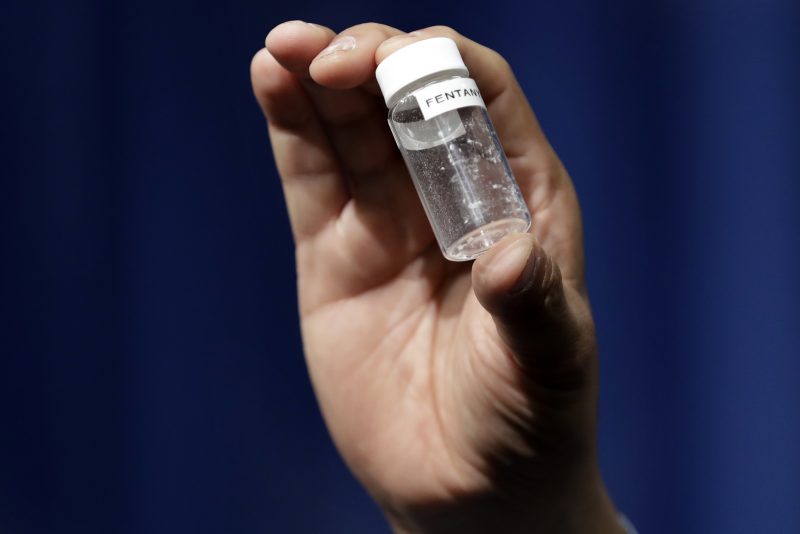
DEA said it seized enough fentanyl to kill us all. The claim adds up.
“In the past year, the men and women of the DEA have relentlessly worked to seize over 379 million deadly doses of fentanyl from communities across the country … enough deadly doses of fentanyl to kill every American.”
— Anne Milgram, administrator of the Drug Enforcement Administration, in a statement, Dec. 20
“This year alone, DEA has seized enough fentanyl to provide a lethal dose to every American. Much of this fentanyl is in the form of fake prescription pills. In 2021, DEA has seized a staggering 20.4 million fake prescription pills.”
— DEA statement, Dec. 16, 2021
Shortly before the holidays, the DEA made headlines with its announcement that enough doses of fentanyl had been seized by law enforcement in 2022 to kill every American. The statement was issued just days after The Washington Post published a searing indictment of how the DEA and other government agencies had failed over the years to take effective action to stem the flow of fentanyl in the United States, causing a spike in fatal overdoses.
We’re always interested in explaining how such figures are calculated, as it was not obvious in the DEA announcement. We were especially puzzled because the DEA made a similar claim at the end of 2021, but with less specificity — and the math did not seem to add up when we relied on metrics used in other DEA and Justice Department announcements. After some prodding, DEA provided a senior laboratory official to explain.
The DEA, along with other law enforcement agencies, tracks and seizes illicit drugs in the United States. The agency is not including fentanyl seizures at the border by Customs and Border Control — which, for fentanyl powder, in fiscal 2022, was almost 50 percent higher than the number (“more than 10,000 pounds”) cited by DEA.
Fentanyl, a synthetic opioid, is 50 times more powerful than heroin. As it has flooded into the United States, it increasingly has been mixed with other drugs, such as heroin, cocaine, methamphetamine and MDMA, so that some users may not realize that the product they purchased was laced with fentanyl. Counterfeit prescription pills can also be laced with fentanyl, sometimes in lethal doses.
What’s a lethal dose? The DEA estimates that about 2 milligrams of pure fentanyl is lethal, though officials acknowledge that it varies by person, depending on body size, tolerance and past usage. An average adult male might be able to tolerate as much as 3 milligrams. But even that is just a few grains, barely enough to fit on the tip of a sharpened pencil.
According to the National Institute on Drug Abuse, a person overdosing on fentanyl slows his or her breathing — or even stops breathing entirely — and thus less oxygen reaches the brain, causing a coma, brain damage or death.
There are two parts to the DEA’s calculation — potential deaths from counterfeit pills and potential deaths from powder. Let’s look at the powder first.
During the year, the DEA lab official said, the agency tested more than 1,000 samples of seized fentanyl. On average, the powder had 14.4 percent purity. So 10,000 pounds of seized powder would amount to 1,440 pounds of pure fentanyl. DEA officials then divided the amount seized — which was described as more than 10,000 pounds — by 2 milligrams, yielding about 353.5 million potentially lethal doses of the powder.
As for the fake pills, DEA says it seized 50.6 million of them. For most of the year, DEA testing indicated that 4 out of 10 pills contained a lethal dose. But that changed in October, after the agency announced that 6 out of 10 pills had a lethal dose.
So, to calculate the number of pills with lethal doses, the agency assumed 40 percent from January to September (about 17 million pills) and 60 percent from October to December (8 million). That adds up to about 25.5 million doses.
Combining the estimates for powder and pills yields 379 million. About 330 million people reside in the United States.
Still, if one assumes a lethal dose was 3 milligrams, as some law enforcement officials have said, including at the DEA, then that would cut the number of lethal doses from powder to 235 million, and DEA would fall well short of its headline-making statistic.
We found that some law enforcement officials, including at the DEA, also have not been careful about accounting for the purity of fentanyl powder. For instance, a Feb. 2, 2021, news release said that “DEA’s 9 kilograms of fentanyl seized in Iowa last year carries enough lethal doses for four-and-a-half million users.” The news release made the mistake of assuming the seizure was 100 percent pure.
A DEA official noted that the news release predated the arrival of Milgram, the administrator. He said she was “laser-focused” on working with the DEA lab to provide consistent and accurate numbers. In the past year, the lab has created an internal dashboard that allows officials to get up-to-date estimates on seizures and potential lethal doses with the click of a button. When officials issued the 2021 release, they did not provide a figure for total lethal doses but believed it was more than the U.S. population. The lab official said a recent calculation found it added up to 340 million doses — just enough to make it accurate, assuming a lethal dose is 2 milligrams.
The DEA is able to justify its headline-making number if one accepts that 2 milligrams of pure fentanyl is a lethal dose. That’s probably good enough for government work.
(About our rating scale)
Send us facts to check by filling out this form
Sign up for The Fact Checker weekly newsletter
The Fact Checker is a verified signatory to the International Fact-Checking Network code of principles
